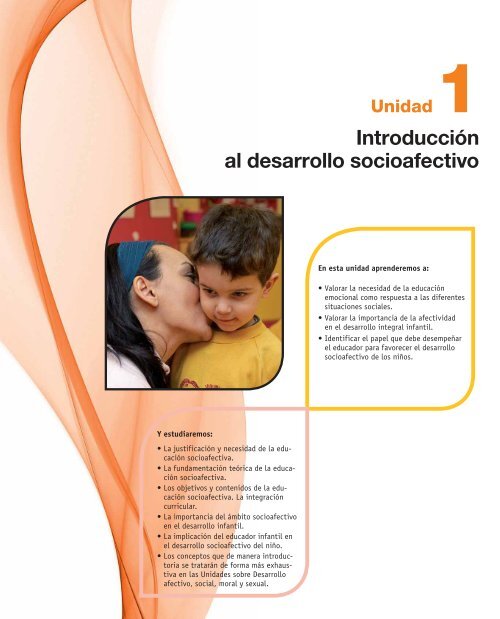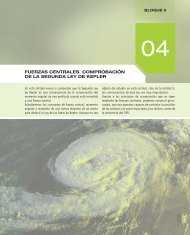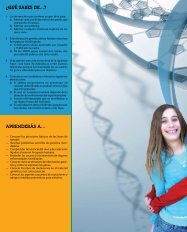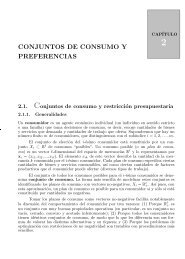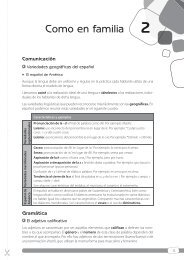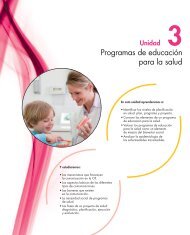Introducción al desarrollo socioafectivo - McGraw-Hill
Introducción al desarrollo socioafectivo - McGraw-Hill
Introducción al desarrollo socioafectivo - McGraw-Hill
Create successful ePaper yourself
Turn your PDF publications into a flip-book with our unique Google optimized e-Paper software.
Y estudiaremos:<br />
1<br />
Unidad<br />
<strong>Introducción</strong><br />
<strong>al</strong> <strong>desarrollo</strong> <strong>socioafectivo</strong><br />
-<br />
<br />
-<br />
<br />
-<br />
<br />
<br />
<br />
<br />
<br />
<br />
-<br />
-<br />
<br />
<br />
En esta unidad aprenderemos a:
8<br />
1<br />
Situaciones<br />
vit<strong>al</strong>es<br />
Situaciones<br />
educativas<br />
Situaciones<br />
soci<strong>al</strong>es<br />
<strong>Introducción</strong> <strong>al</strong> <strong>desarrollo</strong> <strong>socioafectivo</strong><br />
¿Sabías que…?<br />
Informe Delors -<br />
<br />
XXI<br />
-<br />
<br />
-<br />
<br />
-<br />
<br />
1. Justificación y necesidad<br />
de la educación socioafectiva<br />
<strong>desarrollo</strong> <strong>socioafectivo</strong><br />
<br />
<br />
-<br />
<br />
<br />
<br />
<br />
<br />
<br />
<br />
-<br />
-<br />
<br />
objetivo princip<strong>al</strong>-<br />
<br />
justificar la educaciónsocioafectiva<br />
<br />
<br />
<br />
<br />
<br />
<br />
<br />
<br />
<br />
<br />
<br />
<br />
<br />
<br />
<br />
<br />
-<br />
<br />
<br />
<br />
<br />
Fig. 1.1. Justificación y necesidad de la educación socioafectiva.<br />
Justificación y necesidad de la educación socioafectiva<br />
-<br />
<br />
<br />
<br />
<br />
-<br />
-<br />
-<br />
<br />
<br />
<br />
<br />
-<br />
<br />
<br />
<br />
<br />
<br />
<br />
Necesidades<br />
derivadas de las<br />
situaciones vit<strong>al</strong>es<br />
Necesidades<br />
derivadas de las<br />
situaciones<br />
educativas<br />
Necesidades<br />
derivadas de las<br />
situaciones soci<strong>al</strong>es
2. Fundamentación teórica<br />
de la educación socioafectiva<br />
<br />
XIX<br />
movimientos de renovación pedagógica,-<br />
-<br />
<br />
<br />
<br />
psicoterapia,<br />
<br />
<br />
<br />
teoría de las inteligencias múltiples<br />
<br />
<br />
<br />
-<br />
<br />
inteligencia intraperson<strong>al</strong>,-<br />
<br />
inteligencia interperson<strong>al</strong><br />
<br />
teoría de la inteligencia emocion<strong>al</strong><br />
<br />
<br />
<br />
– <br />
– <br />
– <br />
– <br />
– <br />
-<br />
<br />
<br />
Gardner Goleman<br />
<br />
<br />
<br />
<br />
Inteligencia emocion<strong>al</strong><br />
Fig. 1.3. Par<strong>al</strong>elismo entre la teoría de Gardner y la teoría de la inteligencia emocion<strong>al</strong>.<br />
<strong>Introducción</strong> <strong>al</strong> <strong>desarrollo</strong> <strong>socioafectivo</strong><br />
1<br />
¿Sabías que…?<br />
Carl Rogers.-<br />
<br />
<br />
<br />
<br />
<br />
<br />
<br />
Albert Ellis. -<br />
<br />
<br />
<br />
<br />
<br />
Fig. 1.2. Daniel Goleman, psicólogo<br />
c<strong>al</strong>iforniano (1947), autor de la teoría<br />
de la inteligencia emocion<strong>al</strong>.<br />
Vocabulario<br />
Inteligencia emocion<strong>al</strong>. <br />
-<br />
<br />
<br />
<br />
<br />
<br />
9
10<br />
1<br />
<strong>Introducción</strong> <strong>al</strong> <strong>desarrollo</strong> <strong>socioafectivo</strong><br />
Ten en cuenta<br />
emoción y sentimiento<br />
-<br />
<br />
<br />
<br />
1. Sociedades que<br />
favorecen la inteligencia emocion<strong>al</strong> en sus relaciones soci<strong>al</strong>es<br />
<br />
<br />
neurociencia, <br />
<br />
<br />
<br />
Caso Práctico 1<br />
<br />
<br />
<br />
<br />
<br />
Solución:<br />
<br />
-<br />
<br />
Alegría Tristeza Miedo<br />
<br />
<br />
<br />
<br />
<br />
<br />
<br />
<br />
-<br />
<br />
<br />
<br />
-<br />
<br />
<br />
<br />
<br />
Fig. 1.4. Reacciones fisiológicas asociadas a diversas emociones.<br />
-<br />
<br />
<br />
-<br />
<br />
<br />
<br />
<br />
Actividades<br />
2. -<br />
<br />
<br />
<br />
<br />
<br />
<br />
<br />
<br />
<br />
<br />
<br />
<br />
<br />
<br />
<br />
<br />
<br />
<br />
Sorpresa Ira Asco
3. Objetivos y contenidos<br />
de la educación emocion<strong>al</strong><br />
<br />
-<br />
<br />
<br />
Solución:<br />
<br />
<br />
3.1. Objetivos<br />
objetivos-<br />
<br />
gestionar las emociones<br />
<br />
autoconocimiento,autoestimaautonomía person<strong>al</strong>.<br />
relacionarse<br />
sensibilidad<br />
resolución de conflictos.<br />
3.2. Contenidos<br />
A. Competencia person<strong>al</strong><br />
competencia person<strong>al</strong><br />
<br />
Conciencia de uno mismo:<br />
– Conciencia emocion<strong>al</strong>:<br />
<br />
– V<strong>al</strong>oración adecuada de uno mismo:-<br />
<br />
Autorregulación:<br />
– Autocontrol:<br />
– Autoestima y confianza<br />
Automotivación:<br />
<br />
– Motivación de logro:<br />
– Compromiso:<br />
Caso Práctico 2<br />
contenidos,<br />
<br />
<strong>Introducción</strong> <strong>al</strong> <strong>desarrollo</strong> <strong>socioafectivo</strong><br />
1<br />
¿Sabías que…?<br />
<br />
-<br />
<br />
<br />
<br />
<br />
<br />
Mejora-<br />
<br />
Más colaboración-<br />
<br />
Mayor dominio<br />
Vínculos más positivos<br />
<br />
Más habilidad <br />
<br />
Mejor control <br />
Menos conductas<br />
Mejor tolerancia -<br />
<br />
Importante<br />
regulación emocion<strong>al</strong> -<br />
<br />
<br />
11
12<br />
1<br />
<strong>Introducción</strong> <strong>al</strong> <strong>desarrollo</strong> <strong>socioafectivo</strong><br />
Importante<br />
-<br />
<br />
<br />
las<br />
emociones se aprenden, <br />
<br />
<br />
¿Sabías que…?<br />
<br />
<br />
<br />
<br />
<br />
<br />
<br />
<br />
-<br />
<br />
<br />
<br />
<br />
B. Competencia Soci<strong>al</strong><br />
Competencia<br />
person<strong>al</strong><br />
Competencia<br />
soci<strong>al</strong><br />
Fig. 1.6. Para conseguir la competencia person<strong>al</strong> es importante que<br />
el niño aprenda a reconocer sus emociones.<br />
competencia soci<strong>al</strong><br />
<br />
– Capacidad para captar<br />
<br />
– Habilidades de comunicación,<br />
<br />
– Habilidades de autoafirmación <br />
<br />
– Habilidades de resolución de conflictos,<br />
<br />
– Habilidades de ayuda:<br />
– Habilidades de cooperación y trabajo en equipo.<br />
-<br />
<br />
<br />
<br />
<br />
<br />
<br />
-<br />
<br />
Fig. 1.5. Princip<strong>al</strong>es características de los dos tipos de competencias.<br />
Fig. 1.7. En la escuela infantil es importante trabajar el<br />
reconocimiento de las emociones ajenas para favorecer la<br />
competencia soci<strong>al</strong>.
3.3. La integración curricular<br />
-<br />
<br />
<br />
Solución:<br />
-<br />
<br />
<br />
<br />
-<br />
-<br />
contenido afectivo en el<br />
proyecto curricular,<br />
currículum oculto,<br />
<br />
Desde los objetivos.-<br />
<br />
<br />
<br />
-<br />
<br />
<br />
Desde los contenidos. <br />
<br />
-<br />
<br />
Desde el espacio.-<br />
<br />
<br />
Desde los materi<strong>al</strong>es.-<br />
<br />
<br />
Desde el tiempo.-<br />
<br />
-<br />
carácter preventivo<br />
<br />
3. <br />
<br />
<br />
<br />
4. <br />
-<br />
<br />
<br />
Caso Práctico 3<br />
<strong>Introducción</strong> <strong>al</strong> <strong>desarrollo</strong> <strong>socioafectivo</strong><br />
1<br />
Ten cuidado<br />
rabietas <br />
<br />
<br />
<br />
Vocabulario<br />
Curriculum oculto. <br />
-<br />
<br />
<br />
<br />
Actividades<br />
5. <br />
-<br />
<br />
-<br />
<br />
<br />
<br />
<br />
13
14<br />
1<br />
<strong>Introducción</strong> <strong>al</strong> <strong>desarrollo</strong> <strong>socioafectivo</strong><br />
Actividades<br />
6. <br />
-<br />
<br />
<br />
-<br />
-<br />
<br />
<br />
<br />
<br />
-<br />
-<br />
<br />
<br />
<br />
Ten en cuenta<br />
-<br />
<br />
<br />
<br />
<br />
<br />
<br />
<br />
<br />
Importante<br />
pobreza<br />
<br />
<br />
<br />
-<br />
<br />
<br />
<br />
<br />
<br />
exclusión soci<strong>al</strong><br />
<br />
<br />
-<br />
<br />
<br />
4. Importancia del ámbito <strong>socioafectivo</strong><br />
en el <strong>desarrollo</strong> infantil<br />
-<br />
interrelación<br />
de tres factores:<br />
Intelectu<strong>al</strong>es:<br />
<br />
Emocion<strong>al</strong>es:<br />
<br />
-<br />
<br />
Soci<strong>al</strong>es:-<br />
-<br />
<br />
dimensiones de la person<strong>al</strong>idad <br />
<br />
rendimiento escolarprofesion<strong>al</strong><br />
<br />
<br />
<br />
4.1. El <strong>desarrollo</strong> <strong>socioafectivo</strong> y la inclusión soci<strong>al</strong><br />
<br />
<br />
<br />
<br />
marginación soci<strong>al</strong>exclusión<br />
soci<strong>al</strong>, <br />
<br />
<br />
<br />
<br />
Fig. 1.8. Fotograma de<br />
la película de Charles<br />
Chaplin El Chico (The Kid).<br />
El film trata del abandono<br />
de un niño por parte<br />
de una madre soltera,<br />
y de cómo es recogido<br />
por un vagabundo que<br />
lo cría y educa hasta<br />
los cinco años. Chaplin<br />
muestra que recibir el<br />
afecto adecuado ayuda<br />
<strong>al</strong> <strong>desarrollo</strong> de la<br />
person<strong>al</strong>idad del niño<br />
y de sus capacidades,<br />
y lo protege ante las<br />
dificultades soci<strong>al</strong>es.
Carencias de<br />
<strong>desarrollo</strong><br />
<strong>socioafectivo</strong><br />
de niños<br />
excluidos<br />
<br />
<br />
<br />
-<br />
<br />
-<br />
<br />
<br />
<br />
<br />
Fig. 1.9. Consecuencias de las carencias de <strong>desarrollo</strong> afectivo en los niños excluidos.<br />
<br />
<br />
<br />
-<br />
<br />
7. Convención de Derechos del Niño<br />
<br />
8. <br />
<br />
-<br />
-<br />
<br />
<br />
-<br />
<br />
<br />
<br />
<br />
<br />
El País<br />
a) <br />
b) <br />
<br />
<strong>Introducción</strong> <strong>al</strong> <strong>desarrollo</strong> <strong>socioafectivo</strong><br />
Actividades<br />
1<br />
¿Sabías que…?<br />
<br />
-<br />
-<br />
-<br />
<br />
<br />
<br />
<br />
<br />
<br />
<br />
<br />
LUIS AYALA, ROSA MARTÍNEZ Y MERCEDES<br />
SASTRE,Familia, infancia y privación<br />
soci<strong>al</strong>, <br />
Fig. 1.10. Es importante relacionarse<br />
con el niño a través de gestos y<br />
expresiones faci<strong>al</strong>es, de t<strong>al</strong> forma que<br />
se cree un ambiente <strong>socioafectivo</strong> entre<br />
los dos.<br />
15
16<br />
1<br />
<strong>Introducción</strong> <strong>al</strong> <strong>desarrollo</strong> <strong>socioafectivo</strong><br />
¿Sabías que…?<br />
Convención<br />
sobre los Derechos del<br />
Niño<br />
<br />
<br />
<br />
<br />
<br />
Vocabulario<br />
Resiliencia. -<br />
<br />
<br />
<br />
<br />
<br />
<br />
Web<br />
<br />
<br />
<br />
<br />
www.revistaeducacion.mec.es<br />
Fig. 1.11. Uno de los objetivos de la<br />
escuela inclusiva es el de enseñar el<br />
aprendizaje de la cooperación.<br />
princip<strong>al</strong>es objetivos<br />
<br />
Mitigar el riesgo<br />
Fijar límites claros<br />
y firmes<br />
Enriquecer vínculos<br />
Enseñar habilidades<br />
para la vida<br />
Construir resiliencia/<br />
competencia<br />
Brindar afecto y<br />
apoyo<br />
Establecer y transmitir<br />
expectativas<br />
elevadas y positivas<br />
Brindar<br />
oportunidades<br />
de participación<br />
significativa<br />
-<br />
<br />
<br />
<br />
<br />
<br />
<br />
<br />
<br />
<br />
<br />
<br />
<br />
<br />
<br />
<br />
<br />
-<br />
<br />
<br />
-<br />
<br />
<br />
<br />
<br />
<br />
-<br />
<br />
-<br />
<br />
<br />
Tabla 1.1. Objetivos de la escuela inclusiva. Fuente: Guijo, «Derechos de la infancia (0-6 años) y<br />
educación inclusiva» en Revista de Educación, nº 347, pp. 55-76, 2008.
5. La implicación del educador infantil<br />
en el ámbito <strong>socioafectivo</strong><br />
climafuertemente<br />
soci<strong>al</strong>izador,<br />
<br />
<br />
<br />
<br />
<br />
-<br />
<br />
<br />
<br />
<br />
<br />
<br />
<br />
<br />
Responsabilidad<br />
del educador ante<br />
las necesidades<br />
socioafectivas<br />
Responsabilidad<br />
del educador ante<br />
las actividades<br />
cotidianas<br />
y rutinarias<br />
Responsabilidad<br />
del educador<br />
como creador<br />
de ambiente<br />
<strong>socioafectivo</strong><br />
<strong>Introducción</strong> <strong>al</strong> <strong>desarrollo</strong> <strong>socioafectivo</strong><br />
Soci<strong>al</strong><br />
<br />
<br />
<br />
<br />
Autoestima<br />
<br />
<br />
<br />
<br />
Mor<strong>al</strong><br />
<br />
<br />
<br />
<br />
-<br />
<br />
-<br />
<br />
<br />
<br />
<br />
<br />
<br />
Fig. 1.12. Responsabilidades del educador infantil en el ámbito <strong>socioafectivo</strong>.<br />
1<br />
¿Sabías que…?<br />
<br />
<br />
<br />
<br />
medio físico<br />
y soci<strong>al</strong>, identidad y autonomía person<strong>al</strong>,<br />
y expresión y comunicación.<br />
<br />
<br />
MINISTERIO DE EDUCACIÓN, POLÍTICA SOCIAL<br />
Y DEPORTE 2008. Ev<strong>al</strong>uación de la<br />
educación infantil en España. Informe<br />
del estudio piloto 2007,<br />
www.institutodeev<strong>al</strong>uacion.<br />
mec.es<br />
17
18<br />
1<br />
<strong>Introducción</strong> <strong>al</strong> <strong>desarrollo</strong> <strong>socioafectivo</strong><br />
Caso Práctico 4<br />
<br />
<br />
<br />
-<br />
-<br />
<br />
<br />
<br />
<br />
<br />
Solución:<br />
<br />
<br />
-<br />
<br />
-<br />
-<br />
<br />
<br />
<br />
-<br />
<br />
-<br />
<br />
<br />
<br />
<br />
Actividades<br />
9. <br />
-<br />
-<br />
<br />
<br />
<br />
<br />
<br />
<br />
-<br />
<br />
<br />
<br />
<br />
<br />
AMORÓS, P. Y OTROS, Familia<br />
canguro. Una experiencia de<br />
protección a la infancia. <br />
-<br />
<br />
a) -<br />
<br />
<br />
<br />
Comprender<br />
<br />
Relacionarsegestos, expresiones faci<strong>al</strong>es y contacto físico;<br />
<br />
<br />
<br />
<br />
<br />
-<br />
<br />
<br />
<br />
<br />
residencias de primera infancia,-<br />
<br />
<br />
, <br />
<br />
Responsabilidad<br />
del educador ante<br />
las necesidades<br />
socioafectivas de<br />
los niños excluidos<br />
y en riesgo<br />
de exclusión<br />
<br />
<br />
<br />
<br />
<br />
<br />
<br />
<br />
<br />
<br />
<br />
<br />
<br />
Fig. 1.13. Responsabilidades del educador infantil en el ámbito <strong>socioafectivo</strong> de niños excluidos<br />
o en riesgo de exclusión.<br />
objetivo prioritario-<br />
<br />
<br />
<br />
<br />
formar niños soci<strong>al</strong>mente competentes,
Justificación<br />
de la necesidad<br />
de la educación<br />
emocion<strong>al</strong><br />
Fundamentación teórica<br />
Objetivos y contenidos<br />
Situaciones vit<strong>al</strong>es<br />
Situaciones educativas<br />
Situaciones soci<strong>al</strong>es<br />
Movimientos de renovación<br />
pedagógica<br />
Psicoterapia<br />
(terapia emocion<strong>al</strong>)<br />
Neurociencia<br />
Teoría de las inteligencias<br />
múltiples (Gardner)<br />
Teoría de la inteligencia<br />
emocion<strong>al</strong> (Goleman)<br />
<strong>Introducción</strong> <strong>al</strong> <strong>desarrollo</strong> <strong>socioafectivo</strong><br />
Necesidades derivadas<br />
Psicología humanista<br />
Competencia person<strong>al</strong>: conciencia emocion<strong>al</strong>, autorregulación y automotivación<br />
Competencia soci<strong>al</strong>: conciencia, sentimientos y necesidades de los otros,<br />
y habilidades soci<strong>al</strong>es<br />
1<br />
Síntesis<br />
Music<strong>al</strong>, cinéticocorpor<strong>al</strong>, logicomatemática,<br />
lingüística, y espaci<strong>al</strong> Interperson<strong>al</strong><br />
e intraperson<strong>al</strong><br />
Entender, controlar y modificar estados<br />
emocion<strong>al</strong>es en uno mismo y en otros para<br />
mejorar las relaciones<br />
En consecuencia<br />
Integración curricular: el aspecto <strong>socioafectivo</strong> en todos los elementos del currículo<br />
Importancia<br />
del ámbito <strong>socioafectivo</strong><br />
en el <strong>desarrollo</strong><br />
Implicación del<br />
educador en el<br />
<strong>desarrollo</strong> <strong>socioafectivo</strong><br />
Psicoanálisis<br />
Terapia racion<strong>al</strong> emotiva<br />
Repercusiones gener<strong>al</strong>es:<br />
<br />
<br />
<br />
El <strong>desarrollo</strong> sociafectivo y la inclusión soci<strong>al</strong>:<br />
<br />
<br />
Ante las necesidades socioafectivas del niño<br />
Labor socioafectiva en las tareas cotidianas<br />
Creador de ambiente <strong>socioafectivo</strong><br />
Ante las necesidades socioafectivas de los<br />
niños excluidos<br />
19
20<br />
1<br />
<strong>Introducción</strong> <strong>al</strong> <strong>desarrollo</strong> <strong>socioafectivo</strong><br />
Deducir la necesidad de la educación emocion<strong>al</strong> como respuesta<br />
a las diferentes situaciones soci<strong>al</strong>es<br />
1. <br />
-<br />
, <br />
<br />
<br />
2. <br />
<br />
<br />
<br />
<br />
-<br />
<br />
<br />
<br />
<br />
3. <br />
<br />
4. <br />
<br />
<br />
<br />
5. <br />
-<br />
<br />
<br />
<br />
6. <br />
<br />
<br />
<br />
7. <br />
-<br />
<br />
<br />
-<br />
<br />
Comprueba tu aprendizaje<br />
8. <br />
<br />
<br />
<br />
9. <br />
<br />
<br />
<br />
<br />
<br />
<br />
-<br />
<br />
<br />
<br />
<br />
<br />
Cómo educar la afectividad, la autoestima y las<br />
actitudes en la escuela<br />
10. -<br />
<br />
<br />
V<strong>al</strong>orar la importancia de la afectividad en el <strong>desarrollo</strong><br />
integr<strong>al</strong> infantil<br />
11. <br />
<br />
<br />
<br />
12. <br />
<br />
-<br />
<br />
a) <br />
b) <br />
<br />
13. <br />
<br />
14. <br />
<br />
-<br />
-<br />
<br />
<br />
-<br />
<br />
15.
-<br />
-<br />
<br />
16. <br />
<br />
<br />
<br />
Fig. 1.14. R<br />
<strong>Introducción</strong> <strong>al</strong> <strong>desarrollo</strong> <strong>socioafectivo</strong><br />
1<br />
Comprueba tu aprendizaje<br />
17. <br />
<br />
<br />
<br />
Identificar el papel que debe desarrollar el educador para<br />
favorecer el <strong>desarrollo</strong> <strong>socioafectivo</strong> de los niños<br />
18. <br />
<br />
<br />
19. <br />
-<br />
<br />
<br />
<br />
20. -<br />
<br />
<br />
<br />
<br />
21
22<br />
1<br />
<strong>Introducción</strong> <strong>al</strong> <strong>desarrollo</strong> <strong>socioafectivo</strong><br />
1. -<br />
<br />
a) <br />
b) <br />
<br />
c) <br />
d) a) b) <br />
2. <br />
<br />
<br />
a) <br />
b) <br />
c) <br />
d) <br />
3. <br />
<br />
<br />
<br />
a) <br />
b) <br />
c) <br />
d) <br />
4. <br />
a) <br />
b) <br />
<br />
c) <br />
d) a) b) <br />
5. <br />
<br />
a) -<br />
<br />
b) <br />
<br />
c) <br />
d) <br />
6. <br />
a) <br />
b) <br />
c) <br />
d) <br />
7. -<br />
-<br />
Test de repaso<br />
<br />
<br />
a) <br />
b) <br />
c) <br />
d) <br />
8. <br />
<br />
a) <br />
b) <br />
c) -<br />
<br />
d) a) c) <br />
9. <br />
<br />
<br />
a) <br />
b) <br />
c) <br />
d) <br />
10. <br />
<br />
a) <br />
b) <br />
c) <br />
d) <br />
11. <br />
a) <br />
<br />
b) <br />
c) <br />
d) <br />
12. <br />
-<br />
<br />
a) <br />
<br />
b) <br />
<br />
<br />
c) -<br />
<br />
d)


